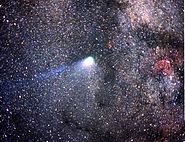
Great Comet
Background to the schools Wikipedia
The articles in this Schools selection have been arranged by curriculum topic thanks to SOS Children volunteers. Before you decide about sponsoring a child, why not learn about different sponsorship charities first?

A Great Comet is a comet that becomes exceptionally bright. There is no official definition; often the term will be attached to comets that become bright enough to be noticed by casual observers who are not actively looking for them, and become well known outside the astronomical community. Great Comets are rare; on average only one will appear in a decade. While comets are officially named after their discoverers, Great Comets are sometimes also referred to by the year in which they appeared great, using the formulation "The Great Comet of...", followed by the year.
Causes
The vast majority of comets are never bright enough to be seen by the naked eye, and generally pass through the inner Solar System unseen by anyone except astronomers. However, occasionally a comet may brighten to naked eye visibility, and even more rarely it may become as bright or brighter than the brightest stars. The requirements for this to occur are: a large and active nucleus, a close approach to the Sun, and a close approach to the Earth. A comet fulfilling all three of these criteria will certainly be spectacular. Sometimes, a comet failing on one criterion will still be extremely impressive. For example, Comet Hale–Bopp had an exceptionally large and active nucleus, but did not approach the Sun very closely at all, yet it still became an extremely famous and well observed comet. Equally, Comet Hyakutake was a rather small comet, but appeared bright because it passed extremely close to the Earth.
Size and activity of the nucleus
Cometary nuclei vary in size from a few hundreds of metres across or less to many kilometres across. When they approach the Sun, large amounts of gas and dust are ejected by cometary nuclei, due to solar heating. A crucial factor in how bright a comet becomes is how large and how active its nucleus is. After many returns to the inner Solar System, cometary nuclei become depleted in volatile materials and thus are much less bright than comets which are making their first passage through the Solar System.
The sudden brightening of comet 17P/Holmes in 2007 showed the importance of the activity of the nucleus in the comet's brightness. Between October 23–24, 2007 the comet suffered a sudden outburst which caused it to brighten by factor of about half a million. It unexpectedly brightened from a magnitude of about 17 to about 2.8 in a period of only 42 hours, making it visible to the naked eye. All these temporarily made comet 17P the largest (by radius) object in the Solar System although its nucleus is estimated to be only about 3.4 km in diameter.
Close perihelion approach
The brightness of a simple reflective body varies with the inverse square of its distance from the Sun. That is, if an object's distance from the Sun doubles, its brightness is quartered. However, comets behave differently, due to their ejection of large amounts of volatile gas which then also reflect sunlight and may also fluoresce. Their brightness varies roughly as the inverse cube of their distance from the Sun, meaning that if a comet's distance from the Sun is halved, it will become eight times as bright.
This means that the peak brightness of a comet depends significantly on its distance from the Sun. For most comets, the perihelion of their orbit lies outside the Earth's orbit. Any comet approaching the Sun to within 0.5 AU or less may have a chance of becoming a Great Comet.
Close approach to the Earth
For a comet to become spectacular, it also needs to pass close to the Earth. Halley's Comet, for example, is usually very bright when it passes through the inner Solar System every seventy-six years, but during its 1986 apparition, its closest approach to Earth was almost the most distant possible. The comet became visible to the naked eye, but was definitely unspectacular. On the other hand, the intrinsically small and faint Comet Hyakutake (C/1996 B2) appeared very bright and spectacular due to its very close approach to Earth at its nearest during March 1996. Its passage near the Earth was one of the closest cometary approaches on record.
List of Great Comets
Great Comets of the past two millennia include the following:
- Caesar's Comet – 44 BC
- Halley's Comet – 1066
- Great Comet of 1106
- Great Comet of 1264
- Great Comet of 1402
- Great Comet of 1556
- Great Comet of 1577
- Great Comet of 1680
- Great Comet of 1744
- Great Comet of 1811
- Great Comet of 1843
- Donati's Comet – 1858
- Great Comet of 1861
- Great Comet of 1882
- Great Daylight Comet of 1910
- Halley's Comet – 1910
- Comet Skjellerup–Maristany – 1927
- Comet Arend–Roland – 1957
- Comet Seki-Lines – 1962
- Comet Ikeya–Seki – 1965
- Comet Bennett – 1970
- Comet West – 1976
- Comet Hyakutake – 1996
- Comet Hale–Bopp – 1997
- Comet McNaught – 2007
- Comet Lovejoy – 2011

